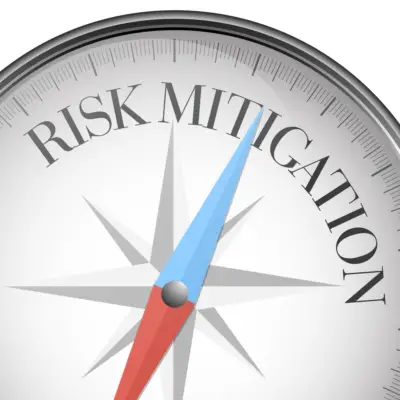Risk mitigation is a crucial aspect of managing risk. It involves developing and implementing strategies designed to reduce the potential impact of threats on an organization. The type of risk a business faces can vary widely, from financial and operational to strategic and compliance risks. Each type of risk requires a different approach to mitigation.
There are several types of risk mitigation strategies that organizations can employ to monitor risk. Low risk and risk levels also need upgrading. These can include risk avoidance, where the organization changes operations to avoid a particular risk altogether. Another strategy is risk reduction, where steps are taken to lessen a risk’s potential impact or likelihood.
Risk sharing or transferring is another strategy often used for financial risks, where the risk is shared or transferred to another party, such as through insurance. Lastly, risk acceptance is a strategy where a business acknowledges the risk but decides to accept it without taking any mitigating actions, often because the cost of mitigation outweighs the potential impact of the risk.
Managing risk effectively requires a thorough understanding of the potential threats an organization faces and the most effective ways to mitigate these threats. Using strategies like risk occurring and understanding the type of risk, businesses can implement the most appropriate mitigation strategies, helping to protect their operations, financial stability, and reputation.
Risk management is an essential aspect of any business enterprise and allows the identification of risk to your business through business objectives. It involves identifying, assessing, and mitigating potential risks while conducting business. Risk management aims to reduce the likelihood of losses and to ensure that the business can continue to operate even in the face of unexpected events.
In this article, we will explore the different types of business risks and the various strategies that can be employed to mitigate them.

Risk Mitigation Tools
Risk mitigation tools identify, assess, and manage organizational risks. Here are some commonly used risk mitigation tools:
Risk Register: This document lists all identified risks, their potential impact, likelihood of occurrence, and strategies for managing them. It’s a living document that should be updated regularly as new risks are identified and existing risks evolve.
Risk Matrix: This visual tool assesses the severity of risks based on their likelihood of occurrence and potential impact. Risks are plotted on a grid, allowing for easy visualization and prioritization.
Risk Assessment Templates: These are standardized forms or checklists to identify and assess risks. They often include categories for describing the risk, assessing its potential impact and likelihood, and noting mitigation strategies.
Risk Management Software: Various software tools can help automate and streamline the risk management process. These tools can help with risk identification, assessment, monitoring, and reporting.
Business Impact Analysis Tools: These tools help identify critical business functions and assess the potential impact of risks on these functions. This can help prioritize risk mitigation efforts.
Scenario Analysis Tools allow organizations to model risk scenarios and assess potential outcomes. This can be particularly useful for strategic and financial risks.
Key Risk Indicators (KRIs): KRIs are metrics used to measure risk exposure in certain areas. They can provide early warning signs of increasing risk.
Heat Maps: These are visual tools used to represent the level of risk in different areas or aspects of the business. They use color coding to indicate the severity of risks, making it easy to identify and prioritize high-risk areas.
Audit Tools: Internal and external audits can help identify risks related to compliance, operational processes, financial reporting, and more. Audit tools can help manage this process and track findings.
Disaster Recovery and Business Continuity Planning Tools: These tools help organizations plan for and manage the risks associated with potential business disruptions.
The goal of Risk Mitigation
Risk mitigation aims to reduce the potential negative impacts of identified risks on an organization’s operations, objectives, or stakeholders to an acceptable level. This is achieved by developing and implementing strategies and actions that aim to prevent the risk from occurring or minimize its impact if it does occur.
Ways to manage business and mitigation
Various strategies can be implemented to effectively manage a business, such as establishing clear goals, implementing efficient processes, and fostering a culture of accountability and innovation.
One of the most important aspects of managing a business is mitigating risk, which refers to identifying potential risks and developing strategies to reduce their impact.
Risk management involves a systematic approach to identifying and assessing risks, implementing strategies to mitigate those risks, and monitoring the effectiveness of those strategies over time.
One of the first steps in developing a risk mitigation plan is to conduct a thorough risk assessment. This involves identifying potential risks and their likelihood of occurring, as well as estimating the potential impact of those risks.
Once risks have been identified, businesses can implement risk mitigation strategies, such as risk avoidance, transfer, reduction, and acceptance. Risk avoidance involves eliminating the risk, while risk transfer involves shifting the risk to another party through insurance or outsourcing.
Risk reduction involves implementing strategies to minimize the impact of the risk, while risk acceptance involves acknowledging the risk and developing contingency plans to mitigate its impact.
Effective risk management requires a proactive approach that involves continuous monitoring and evaluation of potential risks and the effectiveness of risk mitigation strategies.
By establishing clear goals, implementing efficient processes, and fostering a culture of accountability and innovation, businesses can reduce the risk of potential losses and increase their chances of success over time. By implementing a comprehensive risk mitigation plan, businesses can minimize the impact of potential risks and ensure their long-term sustainability and success.
Business risk
One of the most significant challenges organizations face is the potential for unexpected and negative outcomes that threaten their operations and profitability. This type of risk can take many forms, such as financial, operational, reputational, or legal risks. Mitigating these risks is essential for any business to succeed and thrive in a competitive market. To do so, businesses must first identify their potential risks and develop strategies to minimize their impact.
There are different ways to manage business risk, including risk acceptance and risk reduction. Risk acceptance is the willingness to accept the potential risk and its associated consequences. On the other hand, risk reduction involves implementing strategies to reduce the likelihood or impact of potential risks. Businesses must weigh these two approaches’ costs and benefits to determine which is best suited for their needs.
Businesses must incorporate risk management into their overall business strategy to mitigate risk. This includes:
– Conducting a risk assessment to identify potential risks
– Developing a risk management plan that outlines strategies to mitigate risk
– Establishing a business continuity plan to ensure operations can continue during and after a crisis
– Developing a culture of managing risk throughout the organization
This can be achieved through training and education programs that promote risk awareness and encourage employees to report potential risks. By proactively managing risk, businesses can reduce the likelihood of unexpected outcomes and ensure long-term success.
It is also important for businesses to regularly review and update their risk management strategies to adapt to changing circumstances.
Types of risk mitigation strategies on risk mitigation plan
Implementing effective risk mitigation strategies is crucial for organizations to ensure long-term sustainability and resilience in the face of potential threats and uncertainties. Mitigating risk involves identifying, assessing, and monitoring potential risks that could impact your business and taking steps to reduce their likelihood or impact.
A thorough risk management plan should include a range of risk mitigation tools and strategies tailored to the specific needs and goals of the organization.
One common type of risk mitigation strategy is risk avoidance, where the organization avoids a potentially risky situation or activity entirely. This could involve not entering a particular market, not pursuing a certain business partnership, or not investing in a particular asset.
Another strategy is risk transfer, where the organization shifts the risk to another party through insurance or outsourcing. While risk transfer can be effective, it is important to consider the terms and conditions of any agreements to ensure the organization is not left with unexpected liabilities.
Organizations can also mitigate risk through risk reduction strategies and risk culture. This involves taking steps to minimize the likelihood or impact of a potential risk. This could include implementing safety protocols, diversifying investments, or conducting regular risk assessments and audits.
By proactively identifying and addressing possible risks, organizations can ensure their long-term success and sustainability.
Four Types of Risks to Mitigate and Risk Management
Identifying and understanding different types of risks is crucial for organizations to manage potential threats and uncertainties effectively. A risk profile is an essential tool that helps organizations identify and evaluate the different types of risk they face.
By creating a risk profile, a business can prioritize risks and develop strategies to mitigate them. There are different types of risks that organizations may face, including financial, strategic, operational, and reputational risks.
It is crucial to have strategies to minimize risk and protect the organization from potential harm. Risk mitigation strategies include risk avoidance, reduction, sharing, and transfer. To effectively minimize risk, organizations must first identify the risks they face and assess the potential impact of the risk.
Once the identified risks have been evaluated, the organization can develop and implement appropriate risk mitigation strategies. The most effective risk mitigation strategies involve a combination of risk avoidance, risk reduction, risk sharing, and risk transfer.
By proactively managing risks, organizations can better protect themselves from potential harm and improve their overall performance.
Risk mitigation is the process every business, regardless of the type of business, must undertake as part of doing business. It involves identifying and evaluating risks and threats that could impact business operations and objectives, and then putting strategies in place to monitor, manage, and minimize these risks.
Businesses face different types of risk: operational, financial, strategic, and compliance risk. Each risk category requires a unique mitigation approach. For instance, compliance risk might be managed through rigorous adherence to regulations and standards, while operational risk could be mitigated by implementing robust processes and procedures.
The goal of risk mitigation is not to eliminate all risks, as this is unrealistic and could stifle innovation and growth. Instead, effective risk mitigation aims to reduce the likelihood of a risk happening and minimize the impact of risks that do occur. This is achieved by creating a risk-aware culture within the organization, where risk awareness is high and changes in risk are promptly identified and addressed.
Common risk mitigation strategies include risk avoidance, reduction, transference, and acceptance. Risk avoidance involves changing business plans or operations to avoid the risk altogether, while risk reduction seeks to lessen the impact or likelihood of the risk. Risk transference, often used for financial risks, involves shifting the risk to another party, such as through insurance.
Risk acceptance is a strategy where the business acknowledges the risk but decides to accept it, often because the cost of mitigation outweighs the potential impact of the risk.
A risk register is a common risk mitigation tool used to keep track of identified risks, their potential impact, and the mitigation strategies in place. A risk matrix, another useful tool, helps evaluate risk by plotting the likelihood of risk events against their potential impact.
The company’s risk profile, which outlines the different risks to business continuity and how the business can handle them, should be regularly reviewed and updated to account for new risks. This is especially important in a rapidly changing business environment, where new risks can emerge quickly.
Risk mitigation best practices involve a proactive approach to managing risk, with business leaders playing a crucial role in promoting a risk-aware culture. This includes regular risk assessments, continuous monitoring of the business’s risk environment, and ensuring that risk control measures are effective and updated.

Risk Mitigation best practices
Another best risk mitigation practice is regularly assessing and updating the risk management plan. Risks and threats can change over time, and it is important to stay aware of any new risks that may arise. This collaborative approach can help identify potential risks and develop effective mitigation strategies tailored to the organization’s needs and goals.
Managing risk and business continuity
Effective risk management involves assessing potential risks, developing strategies to address them, and regularly monitoring and evaluating their effectiveness.
The first step in managing risk is identifying the type of risk your business faces. Once you have identified the risks, you can develop strategies to address them.
One way to manage risk is through risk avoidance. This involves identifying risks that are too high and avoiding them altogether.
Another way to manage risk is through risk transference. This involves transferring the risk to another party, such as an insurance company.
A risk matrix can also be used to identify the level of risk and prioritize which risks to address first.
Effective risk mitigation involves compliance risk, associated with non-compliance with laws and regulations.
Businesses can mitigate this risk by implementing compliance programs and monitoring them regularly. Mitigation strategies you can use include risk reduction, risk sharing, and risk acceptance.
Frequently Asked Questions
How do you determine which risks are most critical for your business?
Determining critical risks for a business involves identifying potential events that could negatively impact its objectives, prioritizing them based on likelihood and potential impact, and developing strategies to manage or avoid them. Evaluation of risks should be ongoing and updated regularly.
What role does insurance play in mitigating business risks?
Insurance can play a significant role in mitigating business risks by providing financial protection against potential losses. It can help businesses recover from unexpected events such as natural disasters, lawsuits, and other liabilities, reducing the overall financial impact of risks.
How can you balance risk mitigation with your business’s need for innovation and growth?
Balancing risk mitigation and innovation in business requires a comprehensive risk management plan that identifies potential risks, assesses their impact, and develops strategies for mitigating them. This plan should involve collaboration across all levels of the organization to ensure that risk mitigation efforts are aligned with the company’s strategic goals.
What are some common mistakes businesses make when it comes to risk management?
Common mistakes in risk management include failure to identify risks, insufficient risk assessment, inadequate risk response planning, lack of risk monitoring, and poor communication. These can lead to significant financial losses, reputational damage, and business legal liabilities.
How do you communicate risk management strategies to stakeholders, such as investors and employees?
Stakeholders, including investors and employees, can be informed of risk management strategies through clear communication channels and regular updates. A comprehensive risk management plan can demonstrate the organization’s commitment to identifying and mitigating potential risks.

Conclusion
Mitigating risk in business is essential for achieving success. Businesses face various financial, operational, reputational, and strategic risks. To manage these risks effectively, businesses need to implement risk mitigation strategies. These strategies include risk avoidance, reduction, transfer, and acceptance. By identifying potential risks, businesses can determine which strategy to implement and create a management plan.
Creating a risk management plan is one of the most important ways to manage risk. This plan should include a detailed analysis of potential risks and strategies for mitigating them. It should also outline the roles and responsibilities of different organizational individuals for managing these risks.
Additionally, businesses should regularly review and update their risk management plan to ensure it effectively mitigates risks.
Mitigating risk in business is crucial for achieving success. By implementing risk mitigation strategies and creating a comprehensive risk management plan, businesses can minimize the impact of potential risks on their operations, reputation, and financial stability. It is essential for businesses to regularly review and update their risk management plan to stay ahead of potential risks and ensure their long-term success.

Chris Ekai is a Risk Management expert with over 10 years of experience in the field. He has a Master’s(MSc) degree in Risk Management from University of Portsmouth and is a CPA and Finance professional. He currently works as a Content Manager at Risk Publishing, writing about Enterprise Risk Management, Business Continuity Management and Project Management.

